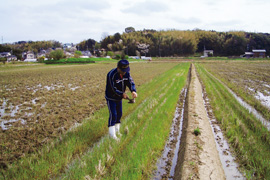The Mitsui & Co. Environment Fund
Introduction to Grant Projects
Environmental Restoration and Conservation Agency of Japan (ERCA)
Research and awareness-raising activities regarding wetlands registered under the Ramsar Convention - the creation and careful use of 'swan' rice
Activity grant
- Project Description
Lake Shinji, which was registered under the Ramsar Convention together with Nakaumi in November 2005, is the southernmost of Japan's wintering sites for tundra swans. Until recently they were reliable sources of food for the swans, but as rice paddies continue to dry up, the food environment is deteriorating. This project aims to use winter-flooding* to provide sources of food for tundra swans, geese, and ducks, as well as reduce the amount of pesticides and fertilizer usied in rice cultivation, to create models for the co-existence of agriculture and nature. To acheive this, it will conduct research on subjects such as the soil and organisms in winter-flooded rice paddies, rice yields, and the number of migratory bird arrivals. In 2008 it increased the number of farming households cooperating with the project by one, and cultivated rice in two locations.
* A farming method where rice paddies are kept flooded after the rice has been harvested.
- Fields
- Marine resources/foodPreservation of biodiversity and ecosystem
- Grant year
- FY2007 Activity Grants
- Grant term
- 3 years
April 2008 - March 2011
- Grant amount
- 4,950,000 yen
- Activity region
- Rice paddies on the northern shore of Lake Shinji, Shimane Prefecture, Japan

Overview of the Organization

- Representative
- Takehiko Hobo, Director
- Establishment
- 1989
- Establishment purpose
- ERCA was established by citizen groups opposed to the desalination of Lake Shinji and Nakaumi with the aim of conserving the lakes following suspension of work on the project in 1988. They perceived a need for citizen action in making policy proposals based on scientific research, and making sure energy was not diffused or lost once objectives had been set, leading to the establishment of a research facility. It conducts surveys and research on the water quality, ecosystems, and aquatic functions of Shimane Prefecture's brackish lakes Shinji and Nakaumi, and how to conserve these, and aims to use the results of this research to contribute to the environmental, social, and cultural development of the surrounding areas.
- Main areas of activity
- The area around Lake Shinji and Nakaumi, Shimane Prefecture, Japan
- Staff
- 1 full-time staff member, 2 part-time staff members, 388 full members
- Annual operating budget
- 11.99 million yen in 2005, 10.16 million yen in 2006, 11.23 million yen in 2007
- Recent activity
-
- (1) Conducted a three-year water quality analysis simulation aimed at repairing Nakaumi's environment following the halt of land reclamation work, presenting Shimane prefectural government with a policy proposal for restoring water flow in the lake by open cutting parts of the reclaimed embankment in 2002. Advocated the inclusion of the lakes under the Ramsar Convention to protect their restoration, with registration for both Lake Shinji and Nakaumi acheived in 2005. This provided an opportunity to develop conservation activities with support from the Mitsui & Co. Environment Fund.
- (2) In 2008, half-crenated ark clams were selected as a marker species for environmental recovery in the Hon-Atsugi area of Nakaumi (1,700ha, originally planned for reclamation) following the open cutting of some sections of reclaimed embankments, and these are being studied in regards to recovery potential.
- (3) The research center also focuses on awareness-raising activities, including publishing materials such as annual reports and newsletters, and holding lectures and nature observation events.